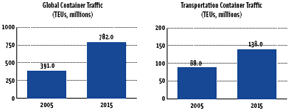Building Canada - Modern Infrastructure for a Strong Canada - Infrastructure and the Economy
Infrastructure and the Economy
Canada's economy is already strong, with growth rates that surpass those of all other G7 nations. However, if Canada is to continue to live up to its potential in a global economy characterized by emerging economic superpowers, international "just-in-time" supply chains and fierce competition, modern, efficient and reliable infrastructure is essential to the country's prosperity today and for the long-term.
Transpacific Container Traffic Forecast 2005-2015
Canada, which is the most trade-dependent nation among the G7, exported goods and services accounting for 38 percent of its Gross Domestic Product (GDP) in 2005. More than $1.8 billion in trade crosses the Canada-US border alone each day. This bilateral trading relationship is the largest economic relationship in the world and, in the last decade, growth in trade with the United States has averaged almost 6 percent annually.1 This sharp and sustained rise in trade and traffic puts relentless pressure on major corridors and border crossings, creating bottlenecks and impeding the flow of goods and people. This is jeopardizing the very economic livelihood upon which Canada depends.
The ports that link Canadians to their world customers—major border crossings between Canada and the United States, the highways, rail lines and waterways that connect all points of the transportation system are all key assets that must meet current and future demands. However many of these assets are already strained, and the economic importance of boosting their capacity cannot be overstated, especially given that Canada's international trade continues to grow at impressive rates.2
Every year, there are roughly 10 million truck trips across the Canada-US border, with the value of goods carried totaling approximately $400 billion.
Transport Canada, Canada's Transportation System
Canada's growing trade with emerging economies, particularly in Asia, is also straining the transportation system. From 1999 to 2004, Canada's merchandise exports to China grew, on average, by 20 percent a year.3 The potential for future growth in commerce between North America and Asia is tremendous. There is also growing demand for exports of bulk commodities and increased use of containers for imports. Against this backdrop, having the infrastructure in place that allows the transportation system to move people and goods - quickly and reliably - is crucial to Canada's competitiveness.
It has been estimated that a $1 increase in the net stock of publicly owned infrastructure capital will generate 17 cents of "cost savings" to private producers per year.
(Statistics Canada, Public Capital and its Contribution to the Productivity Performance of the Canadian Business Sector, November 2003)
Inadequate infrastructure can deter foreign investors. Research shows that inadequate public infrastructure tends to drive away foreign investment more so than quality infrastructure attracts private investment. This, in turn, suggests that public infrastructure is taken "as a given" - something that must be present. In fact, 80 percent of multinational executives believe that poor infrastructure quality affects Canada as an investment destination.4 Public infrastructure is also related to productivity. Congestion, for example, takes a major economic toll - it slows movement of goods and impacts productivity. Transport Canada estimates the total annual cost of congestion in terms of lost time and fuel consumption to be between $2.3 billion and $3.7 billion (in 2002 dollars) for Canada's nine major urban areas.5
Modern infrastructure also creates employment opportunities and attracts skilled knowledge workers, particularly in Canada's urban centres, increasing the cities' growth and competitiveness. Canada's three largest cities (Toronto, Montreal and Vancouver) generate 35 percent of the country's GDP—a major factor in the broader Canadian economy.
[2] Conference Board of Canada, Mission Possible: Sustainable Prosperity for Canada, February 2007.
[3] Quoted in Department of Finance, A Plan for Growth and Prosperity, November 2005.
[4] Industry Canada, Canada's Economic Prosperity: Challenge and Opportunities, June 2006.
[5] Transport Canada, The Cost of Urban Congestion in Canada, March 2006.
- Date modified:
